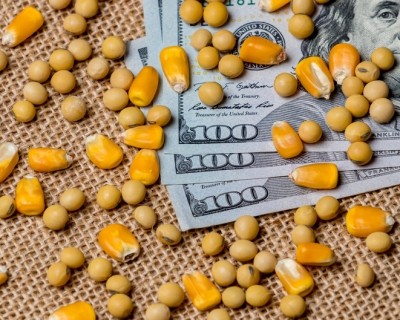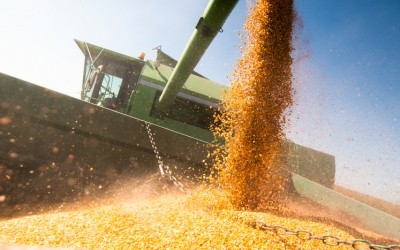WASDE: Corn, soybean yields climb as corn use grows

The US Department of Agriculture (USDA) released updated feed crop and grain production, sales and use information Friday [January 10] in the January World Agriculture Supply and Demand Estimates (WASDE) report.
“There were two surprises in the WASDE, but they ended up sort of canceling each other out,” said Chad Hart, associate professor of economics, crop markets specialist and extension economist with Iowa State University.
The anticipation was that yields for corn and soybeans would drop, he told FeedNavigator. Instead, corn saw a bushel an acre increase, and soybean yields rose half a bushel an acre, although both feed crops did see a decline in acres harvested.
“The other surprise was the movement on the corn feed demand,” he said. “We did see the corn feed number jump fairly significantly [and] that worked out well for the corn market because the export number fell.”
US corn exports, based upon current sales, have been “dismal” and are down about 40%, he said.
The market’s response was fairly neutral with a slight increase in price for both feed ingredients, Hart said. However, there will continue to be “ample supplies” of both corn and soybeans.
“The ending stocks are at levels that will continue to keep prices range-bound,” he said. “I wouldn’t expect to see a dramatic, especially upward, pressure in prices because there are still plenty of corn and soybeans to be had throughout the country.”
The availability of corn also may be pushing winter wheat out of the feed market, he added.
Winter wheat planting saw challenges from the delayed harvest period, Hart said. However, late-season fieldwork traditionally benefits corn planting in the spring.
“The real question might be the same as last year – will weather conditions be dry enough to open up that planting window?” he said. “Looking forward we may have similar prevented planting problems in 2020 – farmers will want to plant the question is will mother nature allow them to.”
Corn, coarse grain production
The US corn outlook for 2019/20 anticipates higher beginning stocks, slightly increased production, growing feed and residual use, falling seed, food and industrial use, declining exports and smaller ending stocks, the USDA said.
Total corn production has been increased 31m bushels to 13.69bn bushels as higher yields offset the drop in harvested area, the department said. Beginning stocks increased 107m bushels based on on-farm and off-farm stocks.
Total corn use increased 155m bushels to 14.07bn while exports fell by 75m bushels based on the shipment pace through December and set the “lowest level of outstanding sales as of early January since the 2012/13 marketing year,” the department said.
Food, seed and industrial use declined 20m bushels, the USDA said. However, feed and residual use increased by 250m bushels to 5.525bn bushels.
Corn stocks for 2019/20 were lowered 18m bushels reflecting that use has been increasing faster than supply, the department said. The season-average corn price remains at $3.85 per bushel.
Globally, corn production is predicted to see increases for Russia, Bangladesh and the EU, the department said. China's feed and residual use of corn increased for both 2018/19 and 2019/20.
Foreign corn ending stocks dropped reflecting reductions for Brazil and China, the department said. Global corn stocks fell 2.8m tons to 297.8m.
Total, international coarse grain production for 2019/20 is anticipated to fall slightly, although, total global coarse grain production is forecast to increase slightly to 1.4bn tons, the USDA said. The EU is also set to see a larger barley crop even as production in China and Australia fell.
Global coarse grain trade for 2019/20 is expected to include higher corn exports for the EU and Ukraine, the department said. Barley exports have been increased for the EU, Argentina and Ukraine, and are only partially offset but a drop in exports from Australia.
Turkey and China are predicted to see an increase in imported barley, the department added.
Soybean and oilseed considerations
Total US oilseed production in 2019/20 fell slightly to 107.4m tons, the USDA said. Increases in soybean production were partially offset by reduced canola, sunflower seed, peanut and cottonseed crops.
Soybean production was increased 8m bushels to 3.56bn bushels based on increased yield, the department said. Harvested acreage is anticipated to drop to 75m acres with the main reductions being in North and South Dakota.
Estimated yield per acre increased 0.5 bushels to 47.4 bushels an acre based on production increases in Illinois and Indiana, the department said. Total soybean supplies saw smaller beginning stocks and imports offset the increased production – ending stocks are forecast at 475m bushels.
The season-average price for soybeans in 2019/20 increased $0.15 to $9 per bushel, the USDA reported said. However, the price for soybean meal fell to $305 per short ton.
International oilseed production in 2019/20 increased based on higher sunflower seed production, especially in Russia, that was only partially offset by production declines palm kernel and palm oil in Malaysia along with drops for cottonseed and rapeseed, the USDA said.
There also was an increase in soybean crush in China based on a “higher-than-expected pace to date,” the department added.
Wheat outlook
The expectation for 2019/20 wheat production is for supplies to be stable with increased feed residual use and reduced stocks, the USDA said. Feed and residual use has been increased by 10m bushels and seed use dropped 1m bushels for the 2020/21 planted area.
Ending stocks fell 9m bushels to 965m bushels, the department said. However, the season-average farm price remains $4.55 per bushel.
Globally, production in 2019/20 dropped 1m tons based on smaller crops in Russia and Australia – although those are partially offset by increased production in the EU, the department said.
Foreign consumption increased slightly, and global exports were raised 1.3m tons, the USDA reported. The EU and Ukraine saw higher exports while they dropped for Russia.
International ending stocks dropped 1.2m tons to 261.8m based on the decline in foreign wheat supplies and increasing use, the department said.












